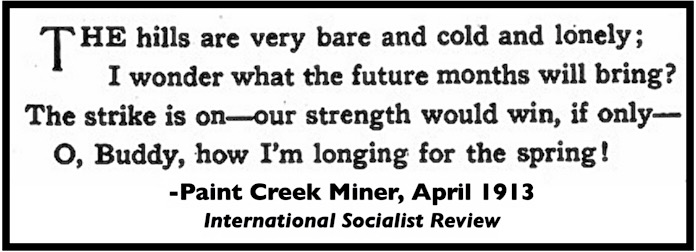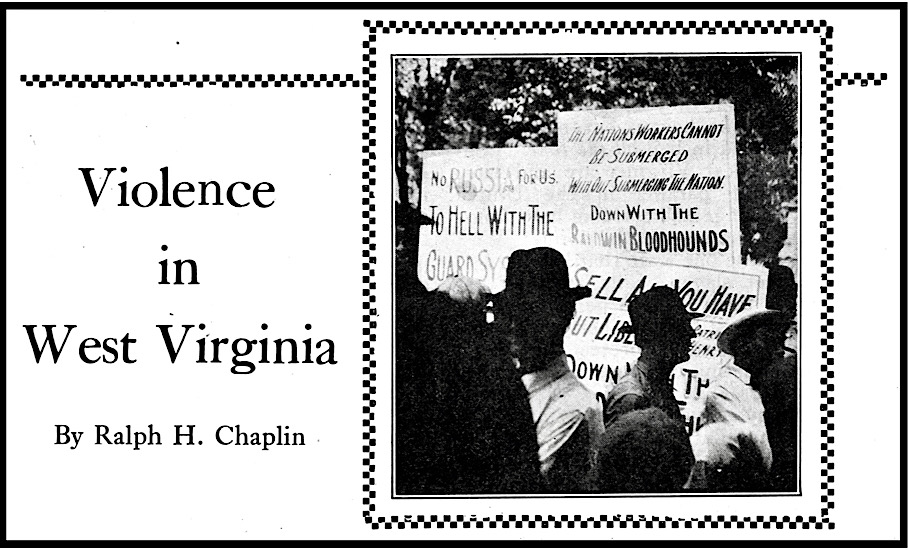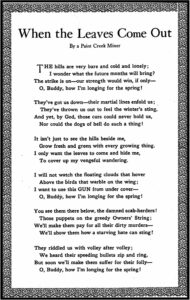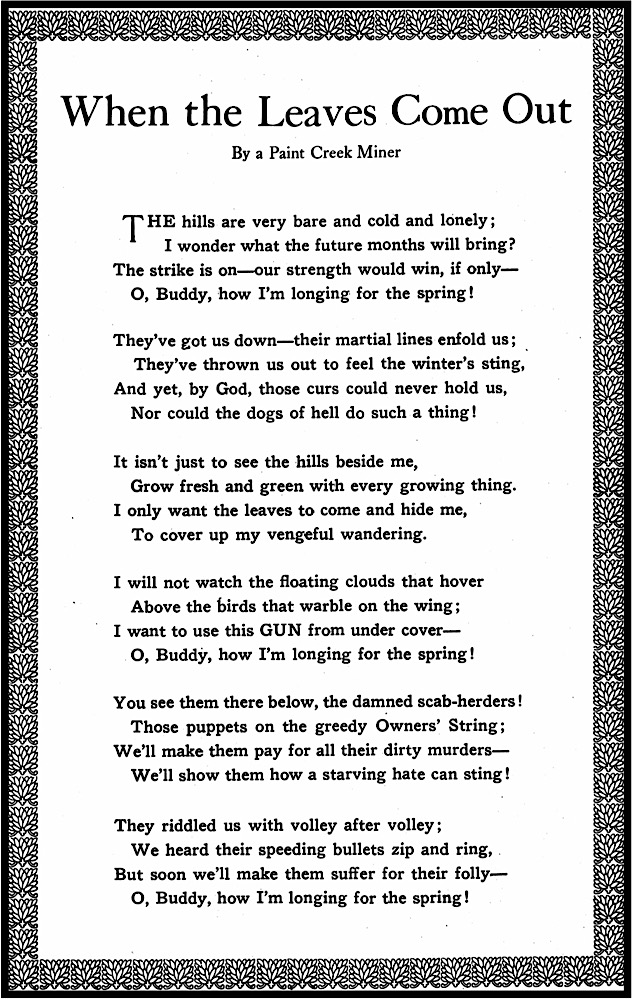 —————
—————
Hellraisers Journal – Thursday April 3, 1913
Ralph Chaplin Travels with Comrade Rumbaugh to West Virginia Strike Zone
From the International Socialist Review of April 1913:
[Part III of III.]
A brief account of a trip made by Comrade Rumbaugh, of Hurricane, W. Va., and myself to the danger zone, might be of interest to readers of the REVIEW. We rode into Charleston “on the front end” and found that city to have the appearance of a place preparing for a siege. Martial law had been declared but a short time previously and the streets were full of soldiers. Yellow-legged sentries were stationed in front of the state house and the governor’s residence. It was rumored that machine guns were mounted in the upper windows of the former building, commanding both entrances to the capitol grounds.
A sentry was also stationed in front of the office of the Labor Argus to guard Comrade W. H. Thompson, who is editing that paper while Comrade Boswell is being “detained” in the bull pen. Comrade Thompson is an ex-Kanawha county coal miner and is unblushingly ”red.” He is the editor of the Huntington Socialist and Labor Star and he has put up as staunch a fight for the cause of the miners as any man in the state. At the city jail we witnessed the interesting spectacle of a bunch of “tin horns” bringing a prisoner from the military district to the city lockup. As the great iron gates swung open to receive them, the spectators commenced hissing the soldiers, calling them “scab herders” and other expressive names. Some of the “yellow legs” glared at these people brazenly but, may they be given due credit, others of the soldiers hung their heads with shame, as if such condemnation from members of their own class was more deadly to them than bullets.
From Charleston we took the labor train that was to carry us into the martial law zone. At Cabin Creek we were almost arrested with a bunch of miners in the car who were poking fun at the grave and ludicrous antics cut by some of the would-be man-killers in khaki. At the Paint Creek junction we remained for several hours, ostensibly to visit some soldier boys of our acquaintance, but in reality to secure information and photographs for the REVIEW and the Labor Star. Comrade Rumbaugh was afterwards arrested and relieved of his camera for attempting to take photographs to illustrate this article. We spoke with dozens of the soldiers, and one of them, an ex-mine guard, admitted that the guards use dum-dum bullets against the miners. He told of two miners who had been killed with these proscribed missiles, one man who had the top of his head completely shot off and another who received a death wound in the breast large enough to “stick your fist into.”
The freight house at Paint Creek has been converted into a bull pen, and over fifty men are now incarcerated there, only three of whom are not native West Virginains. The interior of this place would make a Siberian prison pen look like a haven of refuge. The sleeping accommodations are inadequate, ventilation poor and the floors filthy beyond description. Even with two or three men sleeping in the coal-bin there is no room for the others. The only papers the prisoners are permitted to read are the reactionary local rags and the National Socialist. Mother Jones, Charles Boswell and John Brown have somewhat better quarters elsewhere in town. A sentinel is constantly measuring his paces before the door of each. Dear old Mother Jones in the bull-pen and guarded by armed mercenaries of the Mine Owners! The very thought of it makes blood boil, here in West Virginia.
From Paint Creek we hiked up the Kanawha river to Montgomery and from thence to Boomer. We wanted to have a look at the dauntless Boomer men who are reported to have so willingly gone to the assistance of their brothers down stream, on a certain memorable night. In every little town we passed through, miners were gathered together in little anxious and excited groups. These were all discussing the various phases of the strike, the latest war news, martial law and the coming military trial of the bullpen prisoners. The feeling is prevalent, throughout the Kanawha valley, that if these people meet with an unjust sentence at the hands of the “tin horn” Commission, there will simply be HELL to pay. Nor is this sentiment confined to the strike zone. It extends far out into union territory, not yet affected by the strike, and even into other states.
On my last trip I traveled all through the New River and Green Briar sections of this strife torn state and even on into old Virginia. This entire region seems rotten ripe for real revolutionary unionism. If the splendid spirit of solidarity displayed by these miners could be used effectually against the Operators and their tyrannical system, the result would be inspiring.
If these strikers were permitted by their officials to use the tremendous and irresistible power of the state-wide strike they would set an example for the world. Seldom has the class struggle produced such a splendid and deeply rooted feeling of class solidarity, backed up by such unswerving will and singleness of purpose. Each and every one of them is willing and anxious to get into the fight. They are all ready at a moment’s notice to shoulder the musket of their forefathers and to fight and die for the cause of the strikers. And they would be just as willing to use the bloodless high pressure method of merely putting their hands in their pockets, until a greater degree of justice could be obtained for every organized and unorganized section of the state! These men are not in this struggle to fight; they are in it to win. They would be glad to fight in a bigger and less violent manner-if the Labor “leaders” would only let them.
From Boomer we freighted to Dickenson and had the rare opportunity of watching the whole panorama of the danger district unfold before our eyes. At the two junctions we could plainly see the yellow wigwams of the “yellow legs” with stacked rifles glistening beside them. Sentries were on duty here and there, and once or twice we thought we could catch glimpses of the deadly little machine guns in the rocks overlooking the town. Now and then we could see the frail tent villages of the miners, clustering lonesomely against the hillsides.
At Pratt, four machine guns are being kept in the parsonage of the local Presbyterian minister. This anointed of God is reported to have kindly donated his residence for this purpose in order to testify to his great admiration for “law and order.” And this is the spirit of all of the middle class apologists of the state, not only preachers, but newspapers, politicians and labor fakirs. They are hysterical in proclaiming their love for the “law” and those who uphold it. Noble creatures they are, filled with wrath and fervor, exhorting, denouncing, directing. Mingling with one breath, faded half truths with blackest lies, and hypocritical praise of peace with the hoarse blood-cry of middle-class mediocrity.
But the workers of West Virginia are fast learning that this sickening grimace of respectability is only a mask with which to hide the grimness and cruelty of their real purpose, which purpose seems to be demoralization or organized resistance to the greed of the Operators. These gentlemen are all making violence the only weapon that the miner can possibly use. They all, more or less, favor violence-but violence against the miner only. Violence on the part of a mine guard with his dum-dum bullets or the militiaman with his machine guns is called-heroism, on the part of the striker with a rusty Springfield, it is called insurrection, lawlessness and felony.
Had the miners throughout the state laid down their tools when the strike first commenced, they would have won out, bloodlessly, months ago. But it was not given them to do so. Since that time everything has tended to make them more desperate. The boasted constitutions of the state and nation have been trampled upon before their very eyes, and they themselves have been shot at, scoffed at and outraged repeatedly. And all of these things only served to further stir up newer and fiercer flames in the seething crater of the volcano in Kanawha County. If the miners, as a last resort, seek to use the selfsame weapons which their oppressors are using against them-who is to blame?
Violence is here. I have seen it with my own eyes and I want to ask you “problem solvers” what you are going to do about it. Remember it was the Operators who first thought of using it. They went down into the bowels of the earth and evoked violence to use against the strikers. They dragged it up through the black mouths of the mines and turned it loose. And since that time it has been stalking over the hills like a red Thing from Hell. Some of the more desperate of the strikers welcomed it grimly and bade it do their bidding; some of the more faint hearted, hid and cowered before it praying that the rocks would fall and hide them from it. Timid people shuddered at the sight of it, and “respectable” folk, labor fakirs and students of “tactics,” shook their feeble fists at it, and told it how “wrong” it was. The yelping editorial whores of the local newspapers snarled at it, snapped at its heels, threatening it with hanging, deportation and military execution. But the Thing only sulked away and squatted by the ruins of a burned coal tipple and leered unconcernedly over the bleak hill tops-waiting-waiting for the leaves to come out. WHO IS TO BLAME?
[Emphasis and paragraph breaks added.]
~~~~~~~~~~~~~~~~~~~~~~~~~
SOURCE & IMAGES
International Socialist Review
(Chicago, Illinois)
-April 1913, page 729
https://www.marxists.org/history/usa/pubs/isr/v13n10-apr-1913-ISR-riaz-ocr.pdf
See also:
Hellraisers Journal: From the International Socialist Review:
Ralph Chaplin on Military Violence Against Striking Miners, WV
Part I
Part II
Wobbly
The Rough and Tumble Story of an American Radical
-by Ralph Chaplin
University of Chicago Press, 1948
Full view:
https://catalog.hathitrust.org/Record/001137040
Chapter 11, page 116: The Kanawha Miners’ Strike
https://babel.hathitrust.org/cgi/pt?id=uc1.31210001076247&view=2up&seq=126
-Travels with Comrade Rumbaugh to Strike Zone
https://babel.hathitrust.org/cgi/pt?id=uc1.31210001076247&view=2up&seq=134
When the Leaves Come Out, and Other Rebel Verses
-by Ralph Chaplin
Cleveland OH, 1917
https://archive.org/details/whenleavescomeou00chapiala/page/n1/mode/2up
Tag: West Virginia Court Martial of Mother Jones + 48 of 1913
https://weneverforget.org/tag/west-virginia-court-martial-of-mother-jones-48-of-1913/
Tag: Paint Creek-Cabin Creek Strike of 1912-1913
https://weneverforget.org/tag/paint-creek-cabin-creek-strike-of-1912-1913/
Tag: Ralph Chaplin
https://weneverforget.org/tag/ralph-chaplin/
~~~~~~~~~~~~~~~~~~~~~~~~~
Lyrics by Hazel Dickens



